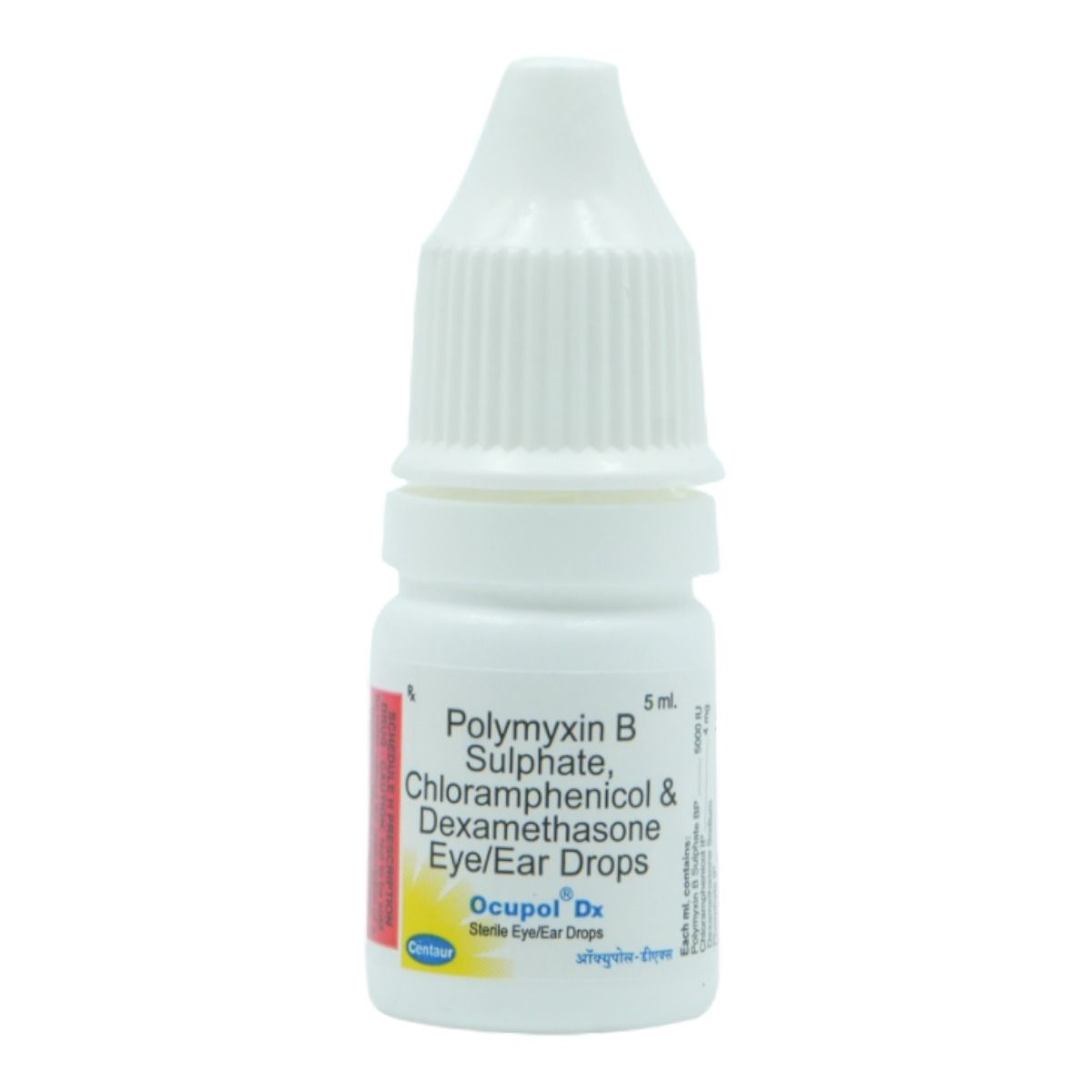Chloramphenicol+dexamethasone
About Chloramphenicol+dexamethasone
Chloramphenicol+dexamethasone is an ophthalmic medication that belongs to the class of 'antibiotics & corticosteroids' primarily used to treat bacterial eye infections, such as conjunctivitis (inflammation of the conjunctiva). A bacterial eye infection occurs when bacteria invade any part of the eyeball or its surrounding tissues, including the cornea (clear front surface of the eye) and the conjunctiva (thin membrane lining the outer eye and inner eyelids).
Chloramphenicol+dexamethasone is composed of Chloramphenicol and Dexamethasone. Chloramphenicol is an antibiotic that works by stopping bacterial growth. Dexamethasone is a corticosteroid that blocks the production of prostaglandins (chemical messengers) that make the affected area red, swollen, and itchy.
Chloramphenicol+dexamethasone is for ophthalmic use only. Common side effects of Chloramphenicol+dexamethasone include redness of the eye, stinging/burning sensation, and temporary blurred vision. These side effects may not occur in every patient using this medication and differ individually. If the side effects persist longer or worsen, please seek a doctor's advice.
Let your doctor know if you are allergic to Chloramphenicol+dexamethasone or any other medications. Avoid contact of the dispensing tip with the eye, eyelids, fingers, and other surfaces to prevent contamination. Pregnant and breastfeeding women should consult their doctor before starting Chloramphenicol+dexamethasone. This medicine may cause temporary blurred vision; hence drive only when you are alert and have clear vision. Chloramphenicol+dexamethasone should be used in children only when advised by a doctor.
Uses of Chloramphenicol+dexamethasone
Medicinal Benefits
Chloramphenicol+dexamethasone consists of Chloramphenicol and Dexamethasone. Chloramphenicol is an antibiotic that works by stopping bacterial growth. Dexamethasone is a corticosteroid that blocks the production of prostaglandins (chemical messengers) that make the affected area red, swollen and itchy. Chloramphenicol+dexamethasone treats bacterial eye infections and relieves symptoms of itching, swelling, and redness caused due to inflammation.
Directions for Use
Storage
Side Effects of Chloramphenicol+dexamethasone
- Redness of the eye
- Stinging/burning sensation
- Temporary blurred vision
Drug Warnings
Inform your doctor if you are allergic to any of the components in Chloramphenicol+dexamethasone. Avoid touching the tip of the tube with bare hands or the eyelids to avoid contamination. If you wear contact lenses, remove them while administering the medicine into the eye. It is advised to check with your doctor before using Chloramphenicol+dexamethasone if you are pregnant or breastfeeding. Avoid driving or operating machines until you have a clear vision since the administration of Chloramphenicol+dexamethasone may cause temporary blurred vision.
Drug Interactions
Drug-Drug Interaction: Keep your doctor informed about all the medicines you take, including prescription and non-prescription drugs, before starting Chloramphenicol+dexamethasone.
Drug-Food Interaction: No interactions were found.
Drug-Disease Interaction: Brief your doctor if you have a medical history of allergic reactions to medicines, liver/kidney diseases, ocular tuberculosis, fungal/viral eye infection, cataracts, glaucoma, and diabetes before using Chloramphenicol+dexamethasone.
Drug-Drug Interactions Checker List:
Safety Advice

Alcohol
cautionThere is limited information on how alcohol consumption affects Chloramphenicol+dexamethasone. Please consult your doctor before using Chloramphenicol+dexamethasone.

Pregnancy
cautionIt is advised to consult your doctor if you plan to conceive or are already pregnant before starting Chloramphenicol+dexamethasone.

Breast Feeding
cautionThere are limited studies on how Chloramphenicol+dexamethasone affects breastfed infants. Please consult your doctor before using Chloramphenicol+dexamethasone if you are breastfeeding.

Driving
cautionChloramphenicol+dexamethasone may cause side effects like temporary blurry vision, affecting your driving ability. Do not drive or operate machinery in such cases. Drive only when you are alert and have clear vision.

Liver
cautionLet your doctor know if you have any history of liver diseases or hepatic impairment. Your doctor will weigh the benefits and potential risks before prescribing Chloramphenicol+dexamethasone.

Kidney
cautionLet your doctor know if you have any history of kidney diseases. Your doctor will weigh the benefits and potential risks before prescribing Chloramphenicol+dexamethasone.

Children
cautionChloramphenicol+dexamethasone is recommended for children only when advised by a doctor.
Habit Forming
Diet & Lifestyle Advise
- Manage stress, eat healthily, drink plenty of water, exercise regularly, and get plenty of sleep.
- Eat food rich in antioxidants such as berries, spinach, kidney beans, dark chocolate, etc.
- Know your allergy triggers, such as pollen, dust and other factors.
- Do not rub your eyes even though some ophthalmic drugs make your eye itchy.
- If you wear contact lenses: Clean and replace contact lenses more often. Never share contact lenses. Always wash your hands before inserting and removing the contact lens.
- Avoid staring at the digital screens for longer durations. Rest your eyes every 20 minutes.
- Avoid or limit the intake of alcohol and caffeine.
Special Advise
It is advised to contact your doctor if the infection symptoms persist or worsen after two weeks of treatment.
Patients Concern
Disease/Condition Glossary
Bacterial eye infection: A bacterial eye infection occurs when bacteria invade any part of the eyeball or its surrounding tissues, including the cornea (clear front surface of the eye) and the conjunctiva (thin membrane lining the outer eye and inner eyelids). A bacterial eye infection symptoms include red eyes, pain, swelling of the eyes, watery eyes, itching, and blurry vision. Some very common eye infections are conjunctivitis (the inflammation and irritation of the eye's mucous membrane (conjunctiva), stye (bump on the eyelid), uveitis (inflammation of the uvea-middle layer of the eye), marginal keratitis (inflammation of the cornea), and blepharitis (inflammation of the eyelids).
FAQs
Chloramphenicol+dexamethasone is an ophthalmic medication that belongs to the class of 'antibiotics & corticosteroids' primarily used to treat bacterial eye infections, such as conjunctivitis (inflammation of the conjunctiva).
Chloramphenicol+dexamethasone consists of Chloramphenicol and Dexamethasone. Chloramphenicol is an antibiotic that prevents bacterial growth. Dexamethasone, a corticosteroid, works by blocking prostaglandins production (chemical messengers) that make the affected area red, swollen and itchy.
It is advised to remove your contact lens while administering Chloramphenicol+dexamethasone. Also, remember to wash your hands before and after using Chloramphenicol+dexamethasone to avoid contamination.
If you use other eye ointments/drops along with Chloramphenicol+dexamethasone, it is advised to maintain a gap of at least 5-10 minutes between each administration. Also, use eye drops before applying any eye ointment.
Avoid contact of the tip of the tube with fingers, eyes, and eyelids. Topical eye products, when contaminated by patients with eye diseases, bacterial keratitis (an infection of the cornea) and ocular infections (eye infections) may occur, which result in vision loss.








